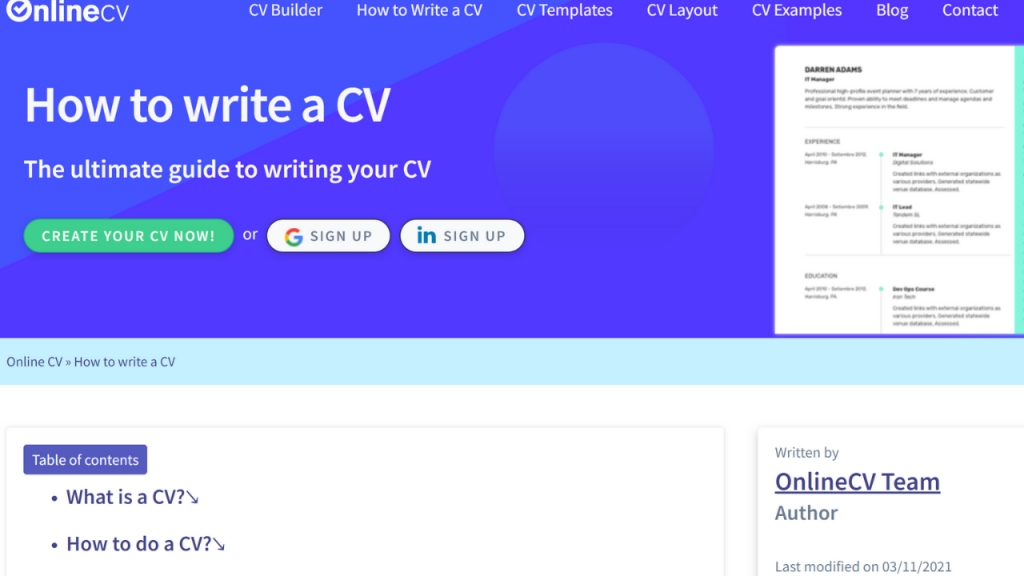Below, you’ll find some simple tips to help you write a CV that will impress your future boss and help you land the job. For more information, check out this ultimate guide to writing your CV.
How to Write a CV
You can create a professional curriculum vitae or CV in a short time. Find out how immediately below;
1. Start With the Basics – Format and Contact Information
First and foremost, your future employer should be able to contact you. Include your first and last name, mailing address, email, and mobile number. Don’t include your date of birth, age, marital status, or other personal information. Don’t include a photo unless you are in the acting or modeling field. This is a good stage to get your document formatting in order. Choose a simple serif or sans serif font such as Times New Roman or Arial. Never use fancy cursive fonts or Comic Sans. Use a font size of 10 to 12 points. Bold your headings to make them stand out.
2. Write a Concise Profile
Your CV profile is “a concise statement that highlights your key attributes and helps you stand out from the crowd.” Briefly mention your career goals, achievements, and relevant skills. One hundred words is a good length to aim for.
3. Back to School
Next, list your educational achievements in reverse-chronological order, starting with the most recent and working your way back. Include the qualification type, institution, grades, and dates. If some coursework was especially relevant, you may include it. Note: this section may be placed after work experience depending on your needs.
4. Work It Out
Next, you will list your previous jobs, also in reverse-chronological order. Each listing should include the job title, company name, dates, and duties. Make sure that your descriptions focus on skills and tasks related to the job to which you are applying. If your work experience is more important than your education, you may place it ahead of the education section.
5. Show Off Your Skills
List and elaborate on your skills, such as foreign languages, programming languages, IT packages, and anything else relevant to the job at hand.
6. Interesting Interests
According to one source, “’Socialising’, ‘going to the cinema’ and ‘reading’ isn’t going to catch a recruiter’s attention. However, relevant interests can provide a more complete picture of who you are, as well as give you something to talk about at the interview. Examples include writing your own blog or community newsletters if you want to be a journalist, being part of a drama group if you’re looking to get into sales, and your involvement in climate change activism if you’d like an environmental job.” If your hobbies aren’t relevant to your prospective job, you can omit this section.
7. Should You Reference Your References?
There is no need to include names and contact information for your references until it is requested. While it is good to have a reference list handy for this stage, don’t include it in your CV. Some people include the phrase “References available upon request,” but this is also unnecessary – your boss knows he has the right to ask for references. In short, you can leave this section out and use the space for more pressing information.
8. Pay Attention to the Length
In some parts of the world, CVs can span a dozen or more pages. In the UK, however, modern CVs should not exceed two A4 pages in length. If your CV is too long, read through it and decide what elements are not relevant to the job you are applying for – what facts don’t matter? Summarise old information (i.e., ten or more years ago) rather than detailing it. Omit the extraneous material. The exception to this might be a highly experienced individual applying for a high-level position. In this case, a three-page CV would be acceptable.
9. Save It Appropriately
Unless instructed otherwise by your employer, you should always save and submit your CV as a PDF file. This ensures it will keep its formatting and be easily readable no matter what device or program is used to open it. Save your file as “[Your name] CV.” This way, you’ll be able to find it again on your computer, and your hiring manager can easily identify it once downloaded.
10. Pair It With a Cover Letter
Your cover letter gives you a chance to explain to the employer why you are a good fit for the job. Not only do cover letters make you look serious and professional, but they are often expected. Your cover letter should be brief – three to five paragraphs, and only one A4 page in length.

